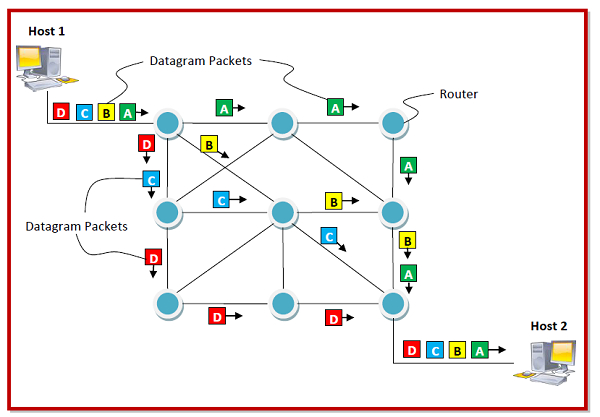
 Data Structure
Data Structure Networking
Networking RDBMS
RDBMS Operating System
Operating System Java
Java MS Excel
MS Excel iOS
iOS HTML
HTML CSS
CSS Android
Android Python
Python C Programming
C Programming C++
C++ C#
C# MongoDB
MongoDB MySQL
MySQL Javascript
Javascript PHP
PHP
- Selected Reading
- UPSC IAS Exams Notes
- Developer's Best Practices
- Questions and Answers
- Effective Resume Writing
- HR Interview Questions
- Computer Glossary
- Who is Who
Datagram Network
In a connectionless communication systems, datagram refers to the smallest unit via which data is transmitted. Datagrams are data packets which contain adequate header information so that they can be individually routed by all intermediate network switching devices to the destination. These networks are called datagram networks since communication occurs via datagrams. They exist in packet switching networks.
Features of Datagram Networks
Datagram switching is done at the network layer of the communication system.
In datagram networks, each data packet or datagram is routed independently from the source to the destination even if they belong to the same message. The network treats the packet as if it exists alone.
Since the datagrams are treated as independent units, no dedicated path is fixed for data transfer. Each datagram is routed by the intermediate routers using dynamically changing routing tables. So two successive packets from the source may follow completely separate routes to reach destination.
In these networks, no prior resource allocation is done for the individual packets. This implies that no resources like buffers, processors, bandwidth, etc. are reserved before the communication commences.
In datagram networks, resources are allocated on demand on a First−Come First−Serve (FCFS) basis. When a packet arrives at a router, the packet must wait if there are other packets being processed, irrespective of its source or destination.
Datagram communication is generally guided by User Datagram Protocol or UDP.
The following diagram shows datagram packets being send by host H1 to host H2. The four datagram packets labelled as A, B, C and D, all belonging to same message are being routed separately via separate routes. The packets in the message arrives in the destination out of order. It is the responsibility of H2 to reorder the packets in order to retrieve the original message.


